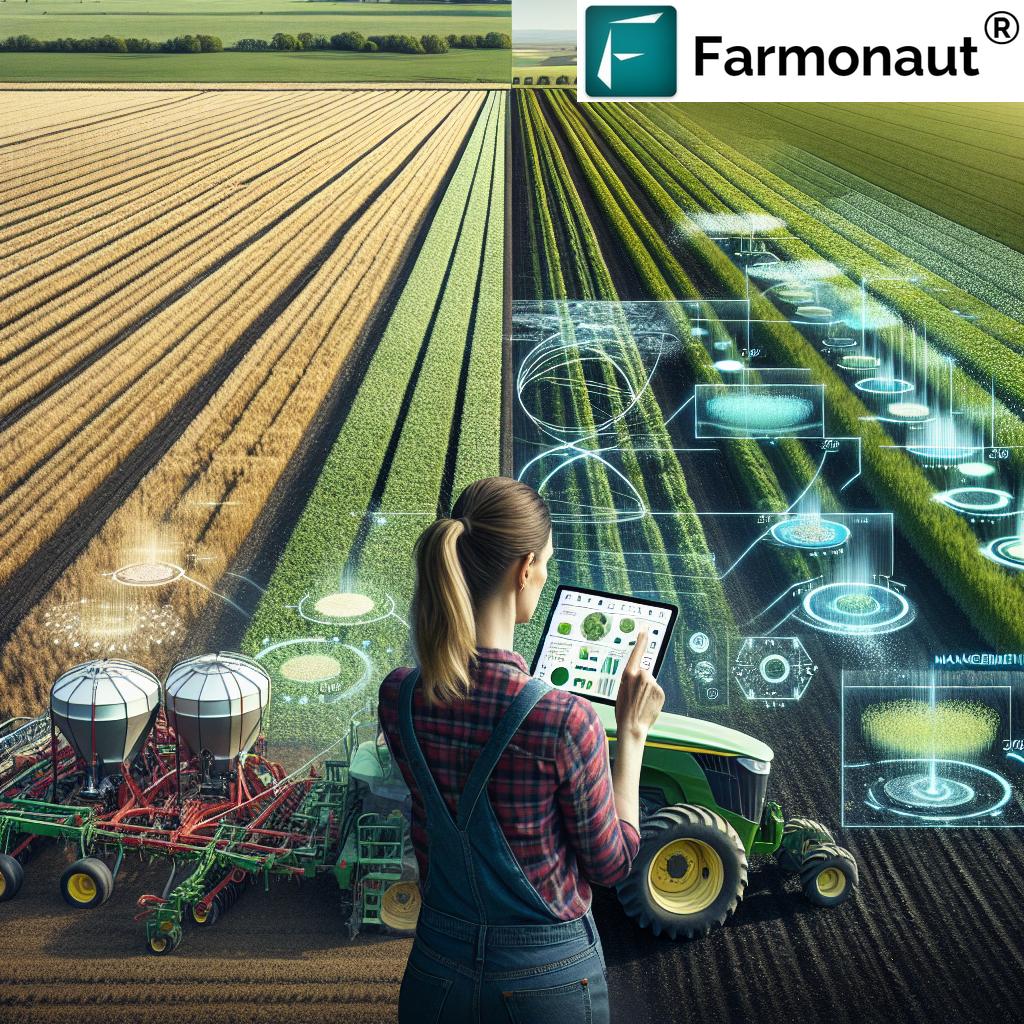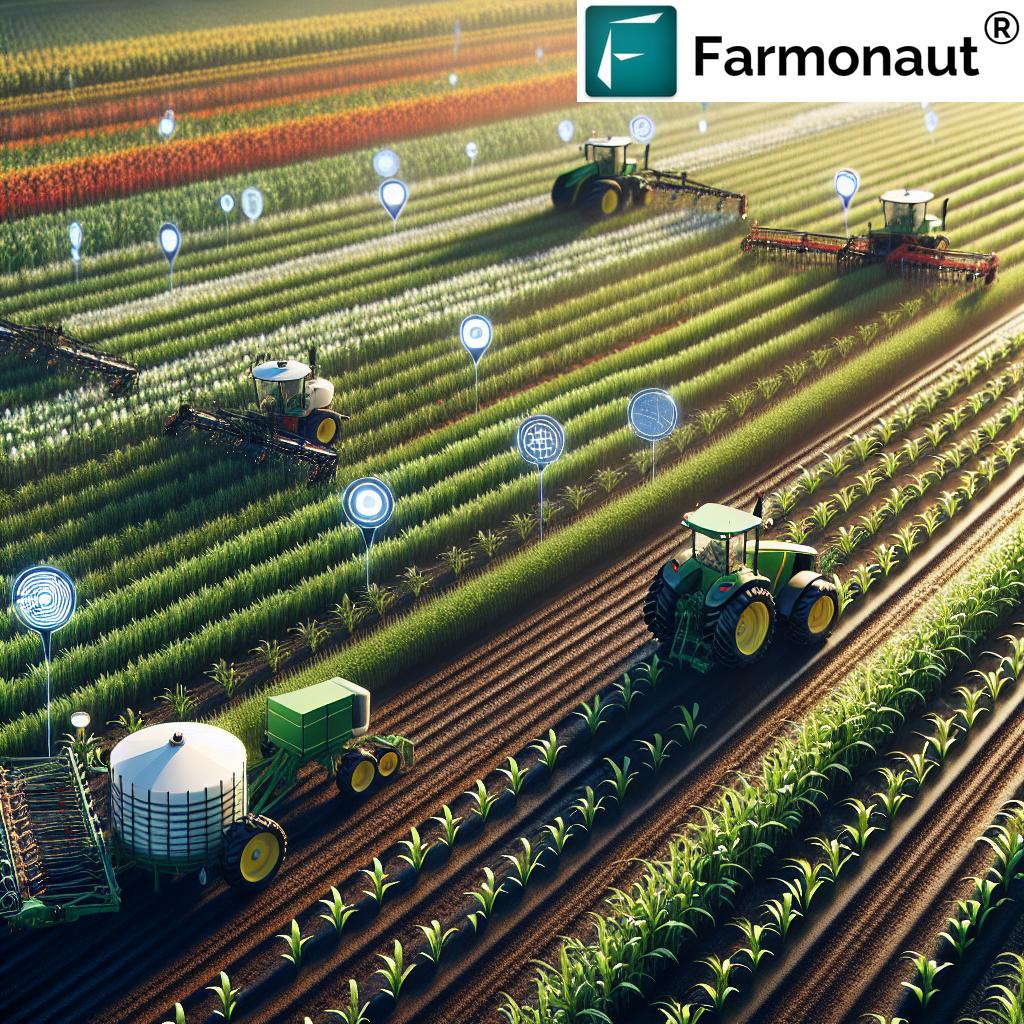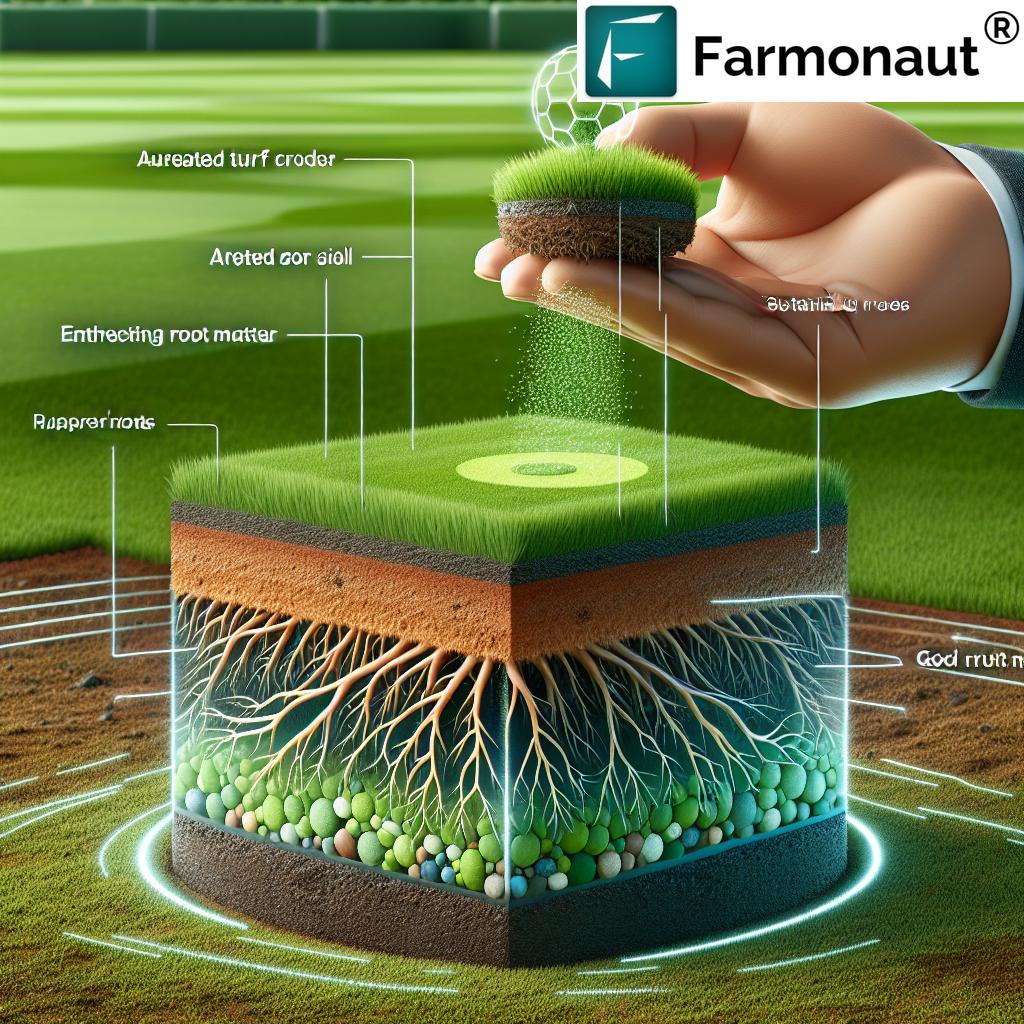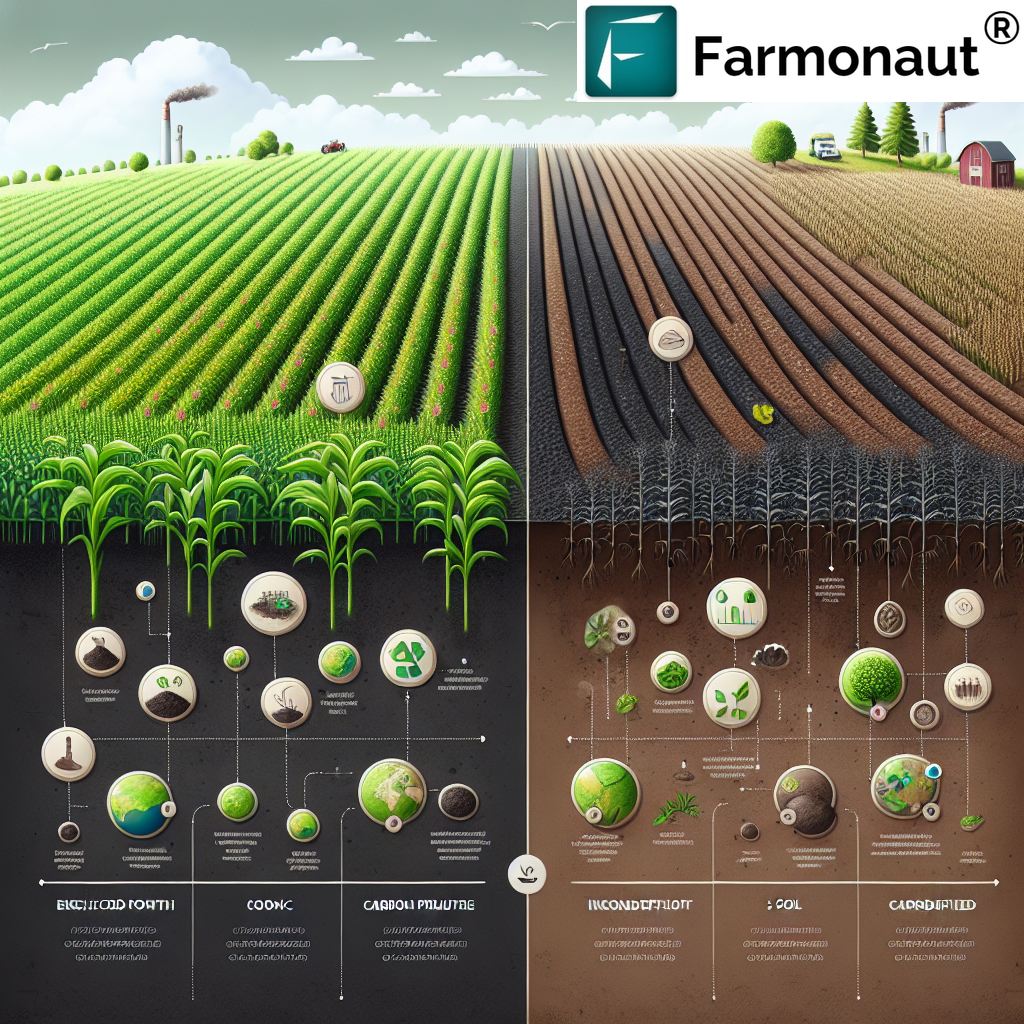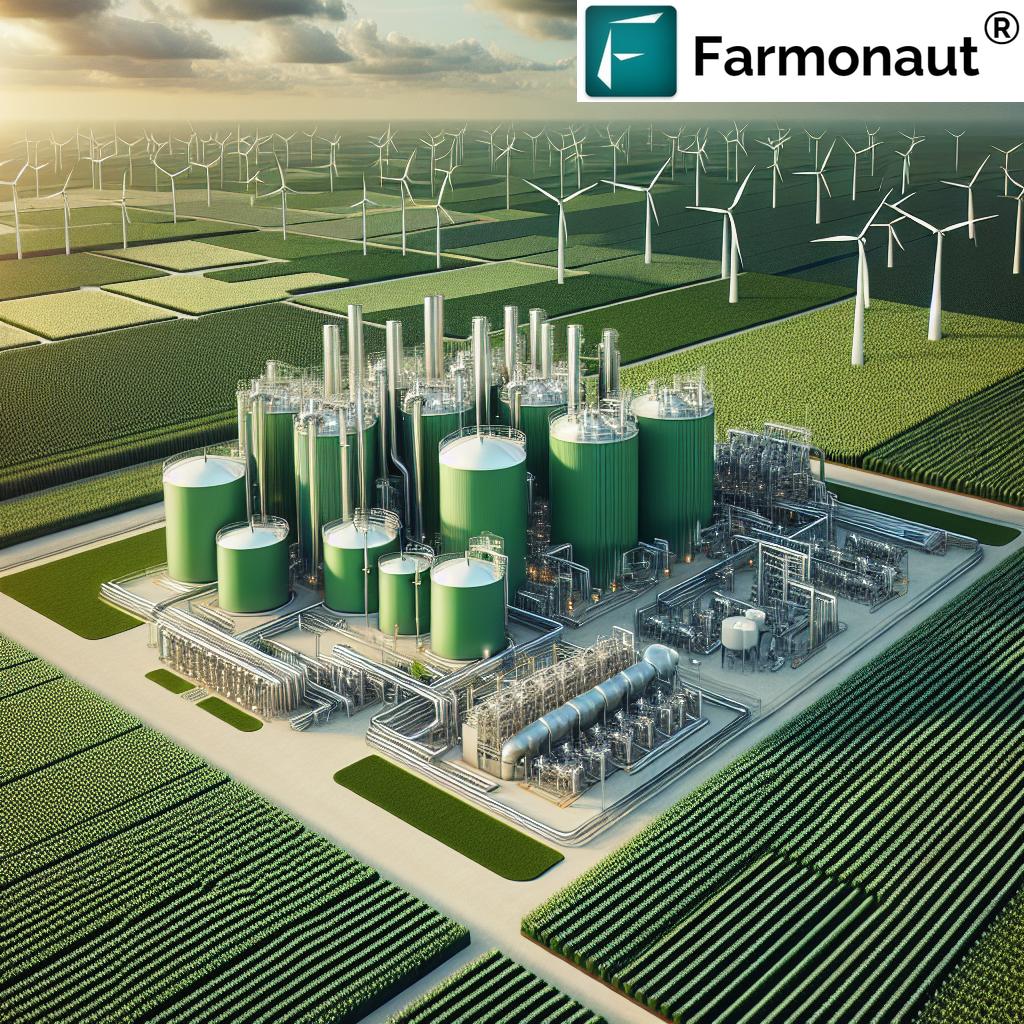Table of Contents
- Introduction: Revolutionizing Efficiency with GPS Controlled Tractors
- Trivia: Impressive Impacts of GPS Guided Tractors
- Key Benefits of Integrating GPS Technology in Tractors
- GPS Controlled Tractors: 7 Ways to Boost Efficiency
- How Farmonaut Empowers Precision Agriculture
- Comparative Table: 7 Efficiency Methods with GPS Tractors
- Challenges & Considerations in Adopting GPS Technology
- What’s Next? The Future of GPS-Guided Tractors
- FAQs: GPS-Controlled Tractors & Related Agriculture Technology
- Conclusion: Advancing Sustainable and Productive Agriculture
GPS Controlled Tractors: 7 Ways to Boost Efficiency
The integration of GPS technology into agricultural tractors has propelled modern farming practices into a new era of precision agriculture. By harnessing the power of the Global Positioning System, farmers can now leverage data-driven solutions, automated control, and advanced navigation systems to optimize operations, enhance sustainability, and maximize crop yields. In this comprehensive guide, we explore how GPS controlled tractors and precision agriculture technology are transforming every aspect of the field, from variable rate application to environmental benefits.
Key Benefits of Integrating GPS Technology in Tractors
The adoption of GPS guided tractors offers immense advantages for agricultural operations. From improved precision in field tasks to substantial reductions in fuel consumption, labor, and operational costs, the impact extends across profitability, sustainability, and ease of management.
- Enhanced Precision: Accurate navigation and automated steering systems eliminate overlaps and missed areas, leading to uniform coverage and resource optimization.
- Efficient Input Usage: The use of variable rate application (VRA) ensures that seeds, fertilizers, and pesticides are applied only where needed, minimizing waste.
- Data-Driven Decision Making: Continuous data collection enables field performance analysis, identification of underperforming areas, and informed management.
- Environmental Sustainability: From reducing chemical overuse and runoff to promoting soil health and biodiversity, GPS technology supports eco-friendly practices.
- Economic Gains: Lower input costs, higher crop yields, and extended operational hours through automation all contribute to increased profitability.
- Future-Readiness: GPS systems can integrate seamlessly with other precision agriculture tools, ensuring adaptability as technology evolves.
GPS Controlled Tractors: 7 Ways to Boost Efficiency
Let’s delve into the seven key methods by which GPS-guided tractors and precision agriculture technology deliver exceptional efficiency and sustainability gains. Each method leverages advanced systems and strategic integration to transform modern farm management:
1. Enhanced Precision and Efficiency in Field Operations
Traditional farming methods often involve manual guidance, which can lead to overlaps or missed areas during planting, fertilizing, and harvesting tasks. GPS controlled tractors address this by following pre-programmed paths with precise navigation. This cutting-edge technology ensures:
- Uniform Coverage: Every inch of the field is cultivated, fertilized, or harvested without missed areas.
- Resource Optimization: Seeds, inputs, and labor are precisely allocated where most needed.
- Reduced Waste: Overlaps are eliminated, minimizing wastage of seeds, fertilizers, and pesticides.
- Lower Input Costs: By maximizing utilization, farmers reduce input waste and associated expenses.
- Increased Sustainability: More sustainable farming practices through optimized field use and minimized environmental impact.
For farmers seeking soil compaction solutions, precise machine movements by GPS tractors reduce unnecessary passes, preserving soil structure and fertility.
Did you know? Efficient fleets and resource management is crucial for maximizing the benefits of GPS-controlled tractors. Our solution helps agribusinesses track vehicles, optimize fuel usage, and minimize downtime with real-time insights.
2. Variable Rate Application (VRA) for Optimal Input Usage
Variable Rate Application is a transformative approach in precision farming. By integrating live field data (from sensors, satellite images, and GPS systems), tractors can adjust the rate of input application such as fertilizers, seeds, and pesticides in real time:
- Field-Specific Adjustments: Inputs are tailored to soil types, moisture levels, and crop health within different areas of a single field.
- Reduced Runoff: Targeted input reduces environmental risks by minimizing chemical overuse and preventing runoff.
- Improved Yields: Crops receive the precise resources required to thrive, helping increase crop yields with GPS.
- Reduced Input Costs: Optimized usage leads directly to significant cost savings.
The Farmonaut Crop Plantation & Forest Advisory can provide satellite-powered insights into field variability, enabling enhanced VRA for your operations.
3. Automated Steering Systems and Operational Control
Automated steering systems represent a major leap in modern farming practices. With auto-steer technology guided by GPS signals:
- Minimal Human Intervention: Tractors operate autonomously, guided along predefined paths without constant operator input.
- Extended Operational Hours: Automated machines can safely work at night or in low-visibility conditions, increasing field work hours.
- Enhanced Consistency: GPS tractors perform repetitive tasks with unwavering accuracy, leading to higher productivity season after season.
- Decreased Operator Fatigue: Automated controls lessen driver fatigue, lowering accident and error rates.
Looking for reliable input verification and ease in insurance claims? Farmonaut’s crop loan and insurance solutions utilize satellite data for efficient, secure, and fraud-proof processes.
4. Advanced Data Collection and Data Driven Farm Management
Data driven farm management becomes a reality with GPS-equipped tractors. Every pass, every application, and every area covered is logged with geo-referenced precision. This data can be harnessed to:
- Track Historical Performance: Analyze trends across seasons and identify underperforming areas.
- Optimize Operations: Recognize which fields yield best results, which inputs drive productivity, and where to make improvements.
- Pinpoint Operational Issues: Data can signal persistent challenges like soil compaction or drainage problems.
- Plan Ahead: Reliable data supports resource management and procurement planning for future planting and harvesting cycles.
As part of our mission at Farmonaut, we make such powerful data analytics and mapping accessible to everyone through our multiplatform apps and API (Developer Docs).
5. Environmental Benefits of Precision Farming
One of the outstanding features of precision agriculture technology is its strong alignment with sustainable and eco-friendly farming practices. By harnessing GPS tractors for careful management:
- Reduce Fuel Consumption in Farming: Accurate field navigation cuts down extra trips, directly reducing fuel consumption and lowering emissions.
- Minimize Chemical Runoff: Targeted application of inputs ensures chemicals are used only as needed, protecting local water systems and biodiversity.
- Combat Soil Compaction: Limiting unnecessary field passes helps preserve soil health and supports healthy root development.
- Enhance Carbon Footprinting: Farmonaut’s carbon footprinting tools enable users to measure and address emissions, making compliance and sustainability actionable in day-to-day operations.
In addition, blockchain-based traceability solutions from Farmonaut allow certifiable environmental claims across supply chains—a game changer for brands committed to eco-friendly practices.
6. Economic Gains and Operational Productivity
The economic advantages of GPS controlled tractors are both direct and indirect. Precision agriculture fosters:
- Lower Input and Fuel Costs: By optimizing every application and field pass, waste is minimized and costs drop.
- Increased Crop Yields with GPS: Data-based management boosts yields, providing more return per acre.
- Decreased Labor Costs: Automated systems require less labor input, freeing up resources for other value-adding operations.
- Maximized Machine Utilization: GPS tractors efficiently allocate time and effort, reducing downtime and supporting larger-scale operations.
- Improved Financing & Risk Reduction: Verified digital records (crop loan & insurance solutions from Farmonaut) can speed up claims and loan approvals, reducing fraud and administrative overhead.
7. Seamless Integration for Large Scale Farm Management
Scalability and adaptability are crucial for today’s agribusinesses and enterprises. GPS-enabled solutions enable:
- Centralized Monitoring and Control: Multiple tractors and field units are controlled via unified platforms, integrating GPS, AI, and satellite insights.
- Web, iOS & Android Accessibility: Technologies, such as Farmonaut Agro Admin App, provide large scale farm management from anywhere, improving decision timelines and operational flexibility.
- API-Driven Expansion: Direct API integration allows farm tech solutions to scale and interoperate with external analytics or enterprise systems, fostering digital transformation in agriculture.
How Farmonaut Empowers Precision Agriculture with GPS Technology
At Farmonaut, our mission is to democratize access to precision agriculture technology and make it affordable and accessible on a global scale. Our platform integrates satellite-based crop health monitoring, AI-driven advisories, blockchain traceability, and fleet management to drive sustainable outcomes. Whether you use GPS-controlled tractors or broader farm digitalization:
- Access satellite insights across all your fields via Android, iOS, web/desktop apps, or our robust API.
- Receive real-time crop health reports (NDVI and more) and moisture analytics to optimize input application.
- Leverage AI-based advisory to further increase efficiency and productivity in all operational areas.
- Monitor and manage carbon footprint and embrace sustainability with confidence. Explore Farmonaut Carbon Footprinting.
- Benefit from blockchain-secured traceability for transparency and compliance in supply chains. Learn more about Farmonaut Product Traceability.
Comparative Table: 7 Efficiency Methods with GPS Tractors
| Efficiency Method | Description | Estimated Efficiency Gain (%) | Sustainability Impact | Potential Yield Increase (%) |
|---|---|---|---|---|
| Enhanced Precision & Coverage | Reduces overlap and missed areas; achieves uniform coverage during all field tasks. | Up to 90% | Significantly reduced fuel and chemical waste | 5–10% |
| Variable Rate Application (VRA) | Applies seeds, fertilizers, and pesticides at optimal, field-specific rates. | 20–30% | Minimized chemical runoff & resource overuse | 8–15% |
| Automated Steering Systems | Maintains precise tractor paths, increases operational hours, and reduces operator fatigue. | 25–40% | Lower emissions & improved soil health | 5–10% |
| Data Driven Farm Management | Advanced data collection, trend analysis, and resource optimization based on GPS data. | 10–25% | Long-term soil fertility & eco-monitoring | 5–12% |
| Environmental Benefits | Reduced fuel, input use, and minimized negative impact on ecosystems. | 15–30% | Lower emissions, less runoff, more biodiversity | Up to 10% |
| Economic Gains | Decreased input, labor, and fuel expenses; increased profitability. | 20–35% | Supports long-term resource sustainability | 8–15% |
| Large Scale Farm Integration | Centralizes operations, resource tracking, and data-driven scaling with digital platforms. | 15–25% | Efficient land & fleet utilization | 5–10% |
Challenges & Considerations in Adopting GPS-Guided Tractors
While GPS-controlled tractors offer game-changing advantages, there are challenges that farmers and stakeholders must consider:
- Initial Investment: High upfront costs for GPS hardware, compatible machinery, and software platforms may factor into budgeting decisions.
- Technical Skills Needed: Successful adoption requires training operators in modern systems and data interpretation.
- Signal Dependency: GPS system reliability can be affected by tall buildings, tree cover, or remote location signal strength.
- Data Security: As extensive data collection becomes standard, ensuring privacy and safeguarding digital assets is paramount.
- Ongoing Support: Maintaining and updating technology requires ongoing attention and supplier support; choosing scalable and reputable technology partners is crucial.
Addressing these issues means weighing short-term investment against long-term efficiency, sustainability, and yield gains.
What’s Next? The Future of GPS-Guided Tractors
The future for GPS guided tractors looks even brighter with continual technological evolution. Anticipate:
- Greater Autonomy: Full self-driving capabilities, cross-platform compatibility, and AI-based decision support.
- System Integration: Seamless connections between tractors, drones, and on-field sensors for real-time adaptation and task automation.
- Scalable Accessibility: More affordable solutions as technology matures, encouraging broader adoption among small and medium farmers worldwide.
- Enhanced Sustainability: As regulatory and market demands for sustainable farming grow, digitally tracked and optimized systems become increasingly necessary.
Every advancement in precision agriculture technology brings us closer to sustainable food security and climate-resilient agricultural landscapes.
FAQs: GPS Controlled Tractors & Modern Farming Technology
What is a GPS controlled tractor?
A GPS controlled tractor is an agricultural vehicle equipped with navigation technology using Global Positioning System signals to automate and enhance field operations for tasks such as planting, fertilizing, and harvesting. This improves accuracy, reduces overlap, and supports efficient input application, revolutionizing modern farming practices.
How does GPS technology reduce fuel consumption in farming?
By providing real-time, precise path guidance and eliminating unnecessary travel over the same field areas (overlap reduction), GPS guided tractors directly reduce the number of field passes, minimizing fuel consumption and environmental impact.
What is variable rate application (VRA) and why is it crucial?
Variable rate application allows for the real-time adjustment of input rates—such as seeds, fertilizers, and pesticides—based on real-time data about soil conditions, crop needs, and environmental factors. This optimizes resource use, increases crop yields, and reduces environmental risks from runoff or over-fertilization.
Does precision agriculture technology benefit soil health?
Yes. Through precise guidance and reduction of excess field passes, GPS-controlled tractors help combat soil compaction, fostering better root growth, water infiltration, and overall soil fertility.
How does data driven farm management improve efficiency?
By logging every operation (area covered, inputs used, timing), farmers can analyze trends, identify underperforming spots, optimize inputs, and adjust practices for future seasons—thus continually improving efficiency and productivity.
What environmental benefits can farmers expect?
Environmental benefits of precision farming include reduced emissions from fuel, minimized chemical application, less runoff, improved water and air quality, and overall sustainable farming.
How can I start integrating GPS technology in my farming operations?
Several paths exist: Upgrade tractors with compatible GPS kits; use cloud-based and app-based farm management solutions such as Farmonaut for satellite monitoring, data analytics, and resource management; and leverage API tools for system integration. Affordable, modular approaches make it easier than ever for diverse farm sizes and types.
Conclusion: Advancing Sustainable and Productive Agriculture
In the evolving landscape of agricultural technology, GPS controlled tractors are redefining what’s possible for farmers—delivering precision, efficiency, and sustainability at unprecedented levels. By integrating advanced systems, leveraging real-time data, and embracing automation, modern farms can increase yields, reduce input waste, and promote environmental stewardship.
With scalable platforms like those we build at Farmonaut, satellite-powered insights, AI-driven advisories, and blockchain-based traceability become accessible to farmers of all scales. The result? Sustainable productivity, enhanced profitability, and a brighter, data-driven future for farming.






